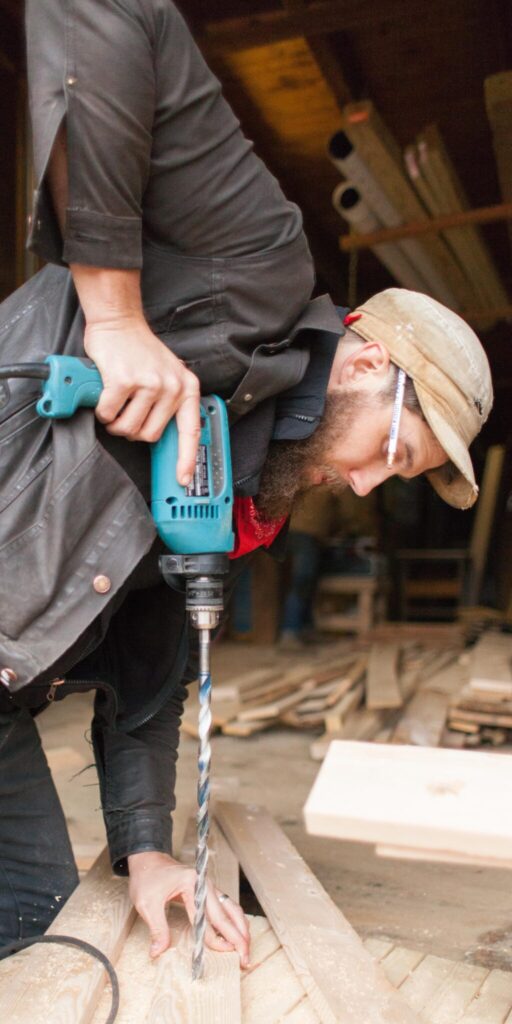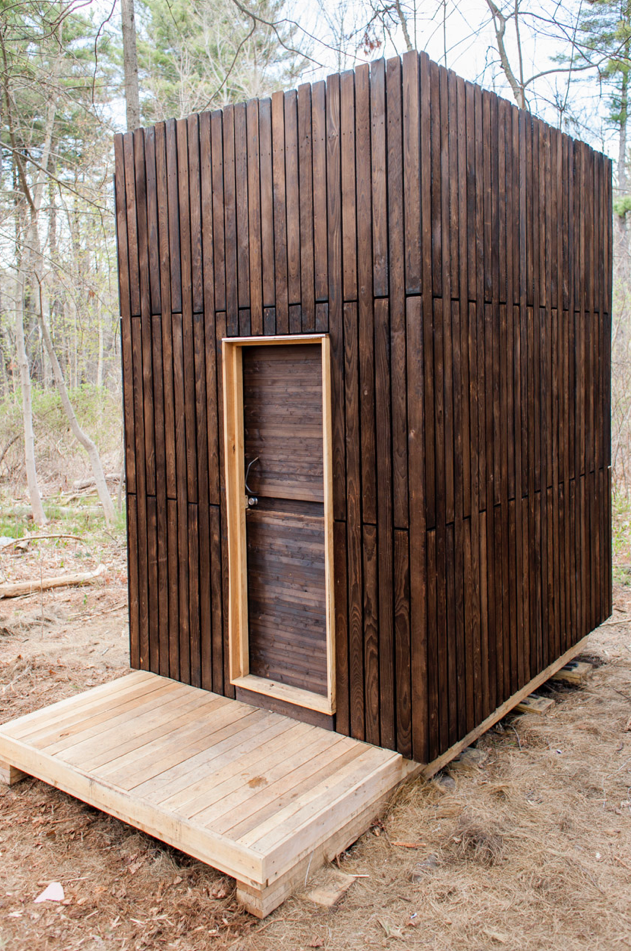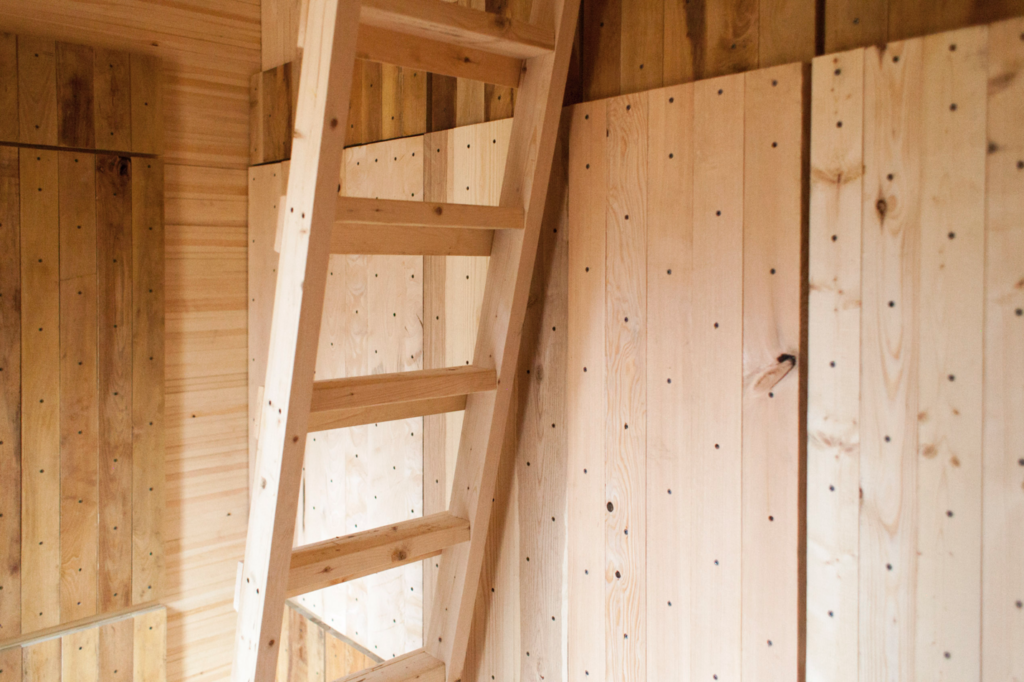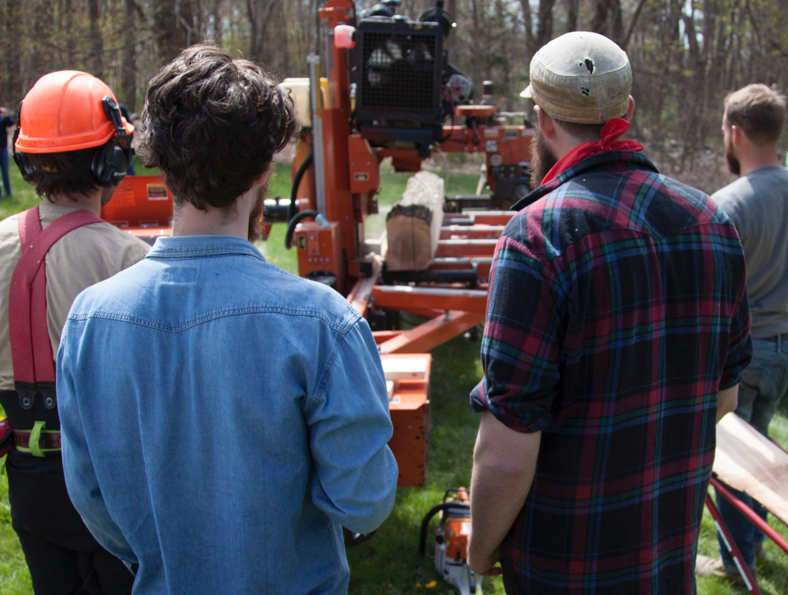The whir of a table saw, the pounding of a hammer, and the roar of a blowtorch—these are the sounds of Harvard graduate students playing hooky in the woods. Starting in the spring of 2016, a group of students from Harvard’s Graduate School of Design have been cutting, nailing, and assembling large, thick panels of wood to construct one-room, full-scale building models near the trailhead of NEFF’s Prouty Woods Community Forest. The students are testing the thermal performance of different species of wood in an effort to change the way the construction industry thinks about and uses wood in mass timber construction.
 Jacob Mans, one of three Harvard students collaborating on the project, lights a small outdoor wood stove on the construction site as he passionately describes the project. “The big idea behind our thesis is that you can’t just talk about wood as a single homogenous thing,” Mans explains. “A lot of architects are talking about cross-laminated timber, glulam, and other [engineered wood] products, but nobody is talking about the types of woods that go into those products, and whether the types of woods that go into a building are from your specific location.”
Jacob Mans, one of three Harvard students collaborating on the project, lights a small outdoor wood stove on the construction site as he passionately describes the project. “The big idea behind our thesis is that you can’t just talk about wood as a single homogenous thing,” Mans explains. “A lot of architects are talking about cross-laminated timber, glulam, and other [engineered wood] products, but nobody is talking about the types of woods that go into those products, and whether the types of woods that go into a building are from your specific location.”
For Mans and his colleagues, wood is more than just a building material; it is an opportunity to build responsibly and sustainably with a natural, renewable resource. Through their work, the team wants to make building with wood as sustainable and as local as possible.
“There are all of these really interesting species, and there are all of these great reasons to use them in buildings, but still everybody is just talking about softwood,” Mans says. “It just doesn’t make any sense to build out of a single species on the east coast, especially out of all softwood, because we have a mixed hardwood forest.” In an effort to challenge the industry standard, Mans, David Kennedy, and Benjamin Peek, Harvard students and founders of the research-based design firm Decentralized Design Lab, are constructing what they refer to as a ‘thermal argument.’
In general, the team explains, denser wood retains heat for a longer period of time. The group is testing the thermal properties of different species by constructing three ‘huts’ using engineered wood, also known as mass timber construction. Each panel is made with a different combination of white pine, spruce, black locust, black birch, hemlock, black ash, and beech, many of which are not typically used in mass timber.
The design team assembles the solid-wood panels on the construction site with standard shop tools, nailing and doweling strips of lumber together into panels that are up to three-and-a-half inches thick, ten feet long, and four feet wide. The panels are then used to construct the floor and walls of the huts, with each hut requiring roughly four thousand board feet of lumber.

Each of the three huts will be rigged with thermal sensors inside and outside the walls. The researchers will heat the buildings, and then track how the different types of wood respond to the heating and cooling process. Through this experiment, Decentralized Design Lab may be able to build an argument for using a wider array of tree species in mass timber construction.
Mans explains what they are trying to accomplish using a familiar example. “In the southwest, people build out of adobe and mud because you can store a lot of heat in really dense materials. They take all of the sunlight that is pouring down all day long, and the energy never makes it inside the structure. We’re trying to do the same thing, but in reverse. Instead of having the heat on the outside and not letting it get into the building, we are trying to heat the inside, and have it return back into the environment after the heater turns off.”
Decentralized Design Lab is already collecting results. “We have stayed over here for several nights when it has been really, really cold,” Peek says. “We turn our heater off, and it’s still a pretty great experience. You touch the wall, and the wall is warm, radiating heat back out to you. It is doing everything that we hoped it would.”
Over the next year, the team will continue to collect thermal data from sensors and cameras, creating a yearlong profile of heating and cooling cycles. But the research isn’t the only outcome of the project.
“We have people who walk by here every day,” Mans says, “They want to go inside the hut, they want to see what it’s like, they want to climb up into the loft—you don’t get that with a scaled model project. Until you build full-scale, you don’t get that human experience, and you don’t realize everything that it could be.”

Working on NEFF’s Prouty Woods has also given the students an opportunity to strengthen connections between architecture and forestry. “Chris Pryor, NEFF’s Director of Forest Stewardship, was saying that we should be thinking about red maple,” Mans explains, “It’s a really aggressive species, there’s lots of it, it’s hard to get high quality wood out of it, and it doesn’t pay to get it out of the woods.” Through their conversation with Pryor, the design team realized that red maple could be a good candidate for mass timber construction because the panels do not require high quality, graded lumber. In addition, red maple is a dense wood. Mans explains, “If we were to use red maple, we would have a panel system that might perform thermally better than a solid pine panel, because it can store more energy.”
To test their theory, the team worked with NEFF and Sean Mahoney from Massachusetts Department of Conservation and Recreation (DCR) to harvest and mill red maple on Prouty Woods. Over the course of three days, NEFF, DCR, and Decentralized Design Lab worked together to harvest red maple, skid the logs out of the woods and to the mill, and mill the logs into boards that will be used to construct the third and final hut.
While the team defended their thesis in May, the research and the various benefits of the project will continue well after Mans, Kennedy, and Peek graduate. The huts will remain near the trailhead of Prouty Woods, and NEFF will be able to use them for educational events and demonstrations.
For Decentralized Design Lab, the huts are just the beginning. “As a group, we want to continue this work in some capacity,” Mans says. “That is why we set up the collaborative called Decentralized Design Lab. The idea is that whether each of us is teaching or working, we can all continue to collaborate and pool our projects and research into a single group.”
Mans, Kennedy, and Peek’s work couldn’t be coming at a more pivotal time for mass timber construction. “Building with wood is blowing up,” Mans says. “You’re seeing more and more wood buildings over the last five years, and you’re going to see more and more of it in the next five to ten years.” There is a revolution in wood construction, and through work like the Harvard students’ thesis project, the revolution will strengthen the ties between the forest, the forest industry, and the buildings from which people work and live.

